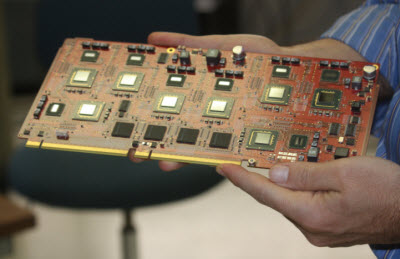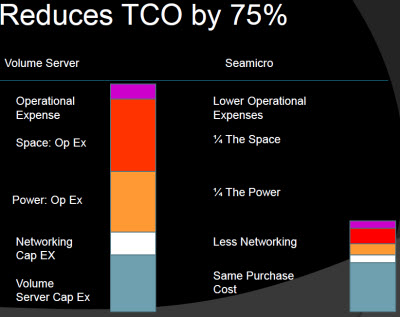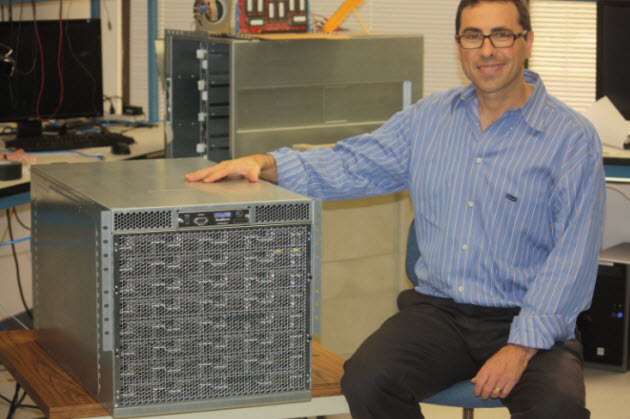Coming out of stealth, SeaMicro is dispelling the Silicon Valley myth that you can’t innovate in hardware anymore. The startup is announcing today it has created a server with 512 Intel Atom chips that gets supercomputer performance but uses 75 percent less power and space than current servers.
It sounds impossible. But if SeaMicro can deliver, then it will deal a big blow to server vendors such as Dell, Hewlett-Packard and IBM. And it could delight customers with big data centers that are consuming too much power and are having a hard time keeping up with the demand for free internet services.
The startup shows a lot of promise because it began 3.5 years ago by rethinking a lot of assumptions. Andrew Feldman, chief executive of Santa Clara, Calif.-based SeaMicro, said in an interview that his team realized that there was a big mismatch between server chips and the workloads they were handling. As the task at hand shifted from doing one big chore at a time for a corporation to serving lots of web pages to millions of people, servers had to change too.
 The big server chips made by companies such as Intel, Advanced Micro Devices, and IBM focused too much on performance and they weren’t power efficient enough. They were, in Feldman’s words, like using the space shuttle to drive to the grocery store.
The big server chips made by companies such as Intel, Advanced Micro Devices, and IBM focused too much on performance and they weren’t power efficient enough. They were, in Feldman’s words, like using the space shuttle to drive to the grocery store.
“Today’s servers are so inefficient when it comes to being properly utilized,” Feldman said. “This misalignment between the server and the work load is the root of the power consumption problem.”
So SeaMicro guessed that servers could benefit instead by using lots of smaller processors, and it got lucky when Intel started promoting its low-power, low-cost Atom chip for netbooks. That lowered power consumption, since Atom processors deliver three times the performance per watt versus Intel’s server chips.
 But SeaMicro also attacked the power consumption in the rest of the system, which accounts for about two thirds of the power consumed by a server. The company did so with a very clever trick known as virtualization.
But SeaMicro also attacked the power consumption in the rest of the system, which accounts for about two thirds of the power consumed by a server. The company did so with a very clever trick known as virtualization.
Today, virtualization is used with servers. It is a layer of software that rests between an application and the servers that it runs on. If an application needs only two servers, the virtualization software finds two available servers to run the application. If the application gets busy and needs 10 servers, the virtualization software finds 10 available servers to do the job. The application is no longer tied to specific servers; the virtualization software frees up the overall system and gets more utilization out of the available servers, as needed to run applications.
SeaMicro did the same thing, but it applied the concept of virtualization to the inside of a server. Feldman designed custom chips that could take the tasks that were handled by everything beyond the Intel microprocessor and its chip set. The custom chips virtualize all of those other components so that it finds the resource when it’s needed. It essentially tricks the microprocessor into thinking that the rest of the system is there when it needs it.
SeaMicro virtualized a lot of functions that took up a lot of space inside each server in a rack. It also did the same with functions such as storage, networking, server management and load balancing. Full told, SeaMicro eliminates 90 percent of the components from a system board. SeaMicro calls this CPU/IO virtualization. With it, SeaMicro shrinks the size of the system board from a pizza box to the size of a credit card.
 By boiling down the rest of the system into a couple of chips, SeaMicro can get rid of a lot of the components in a system, thereby getting rid of space, cost, and power consumption. Put another way, older servers that had 512 microprocessors needed 512 systems with 512 power supplies. SeaMicro can pack 512 Intel Atom chips ito a space that is a quarter of a full server rack. But it only needs four power supplies for that job, as the power supplies are shared by all of those 512 processors. In a full rack, SeaMicro can cram 2,048 Intel Atom chips together in four servers. They are tied together by a supercomputer-like networking technology known as a fabric that operates at 1.28 terabits per second.
By boiling down the rest of the system into a couple of chips, SeaMicro can get rid of a lot of the components in a system, thereby getting rid of space, cost, and power consumption. Put another way, older servers that had 512 microprocessors needed 512 systems with 512 power supplies. SeaMicro can pack 512 Intel Atom chips ito a space that is a quarter of a full server rack. But it only needs four power supplies for that job, as the power supplies are shared by all of those 512 processors. In a full rack, SeaMicro can cram 2,048 Intel Atom chips together in four servers. They are tied together by a supercomputer-like networking technology known as a fabric that operates at 1.28 terabits per second.
This is the revolutionary thinking that leads to all of the dramatic savings. Rivals are not likely to duplicate it because they have gotten used to the idea of building standard systems. They don’t do custom chips in the same way that SeaMicro’s 57 employees did. Every now and then, a new server maker has emerged to make custom chips alongside Intel or AMD chips. But most, such as Azul Systems, have not survived or retreated from their original plans.
Samples of SeaMicro’s SM10000 servers are available today and they will be broadly available on July 30 for $139,000 each. These machines have 512 Intel Atom processors, — all in a server that is just 17.5 inches high, or about a quarter of the space of a typical server rack. It requires no custom software and works in “plug and play” manner with any x86 (Intel-compatible) server data center. You can use x86 or other architecture chips as well, such as ARM.
This advance is coming just in time. Google said recently that if current power trends continue, the cost of energy consumed by a server during its three-year life span could surpass the initial purchase cost for the hardware. The Environmental Protection Agency reports that volume servers consume more than 1 percent of the total electricity in the US—representing billions of dollars in wasted operating expense each year.
SeaMicro created software with millions of lines of code and it created its own custom chips — something that commodity server companies just don’t do anymore. In this endeavor, SeaMicro found a willing ally in Intel. That’s because SeaMicro can increase demand for Atom chips by cramming so many of them into a machine, more than making up for the fact that Intel won’t sell as many server chips under its Xeon brand name.
The company has raised $25 million in two rounds of funding. It was founded by veterans of companies such as Cisco Systems, Juniper Networks, Sun Microsystems, Intel and Advanced Micro Devices. Its backers include Khosla Ventures, Draper Fisher Jurvetson and Crosslink Capital. SeaMicro also won a $9.3 million grant from the Department of Energy. That was the largest grant awarded to a server company.
If you ran a bunch of servers at 100 percent capacity for four years in order to hit a computing task target known as Specint 100,000, you would spend about $1.5 million using Dell servers. Using SeaMicro, you would spend about $428,000. That’s more than $1 million in savings. The point, once again, is that innovation is quite possible in the hardware market if you solve a problem that is causing a lot of pain and costing a lot of money.
VentureBeat's mission is to be a digital town square for technical decision-makers to gain knowledge about transformative enterprise technology and transact. Learn More


